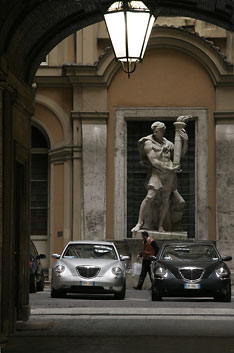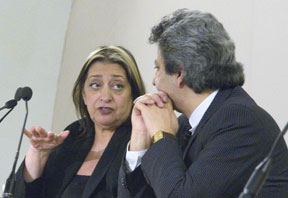Revisiting history and contemplating the modern, Roman style
By Daniel Aloi

From the Pantheon and the Baths of Diocletian to modern structures by Richard Meier '56, historic and contemporary sites were revisited by Cornell in Rome alumni as part of the program's 20th anniversary activities.
"The city has always been our classroom and our laboratory -- and on-site teaching our method," said Jeffrey Blanchard, the program's academic coordinator. "Our view of the history of Rome spans from its origins to the present moment."
While history is everywhere in Rome, many ancient sites have been absorbed by the modern city. A short distance from the program's home at Palazzo Lazzaroni, architecture professor George Hascup pointed out a massive curved apartment building along one alley -- once part of a Roman amphitheater.
Streets in use today that date to the fourth century are "like a red line through history," said Jan Gadeyne, an archaeologist and adjunct professor of architectural history who led tours of the Crypta Balbi Museum. Gadeyne's coursework focuses on such sites as the basilica of Santi Giovanni e Paolo on the Celian Hill. "It basically shows you an urban history from the first to the 12th century, in half a square acre," he said.
Walking tours led by Cornell in Rome faculty included stops at Meier's Ara Pacis Museum, housing the Augustan Altar of Peace rediscovered in the 15th century; and his Millennium Church, commissioned by the Vatican for the Jubilee of 2000.
A group of more than 100 Cornellians toured Renzo Piano's Parco della Musica auditorium complex. Built for multiple performing arts uses, the three scarab beetle-shaped concert halls are designed to maximize acoustics and the audience experience. The group also attended an all-Verdi concert by the prestigious Orchestra e Coro dell'Academia Nazionale di Santa Cecelia.

On the way to the concert facility in Rome's Flaminio district, AAP architecture department chair Mark Cruvellier lingered at the Palazetto dello Sport, or Little Sports Palace, designed by Pier Luigi Nervi for the 1960 Olympic Games.
"This is for all my former students in my structures class -- one can't walk by these things without appreciating them," Cruvellier said, pointing out the concrete dome's interior structural latticework and outer supports. "In a city where the dome is so prevalent, this one is unique," he said. "From the inside, the dome seemingly hovers and floats."
At the construction site of a modern art and architecture museum by Zaha Hadid, Dean Mohsen Mostafavi talked about the architect, who was to give a Cornell-sponsored lecture the following evening.
"Her work has been called calligraphic, and she works with watercolors -- her sketchbooks are very beautiful," he said.
The prominent use of concrete and the flow of movement in the design of her Rome museum project and a science center in Wolfsburg, Germany, indicate that "the nature of Zaha Hadid's work is changing," Mostafavi said. "There is this shift from the calligraphic to the fluid."
Media Contact
Get Cornell news delivered right to your inbox.
Subscribe